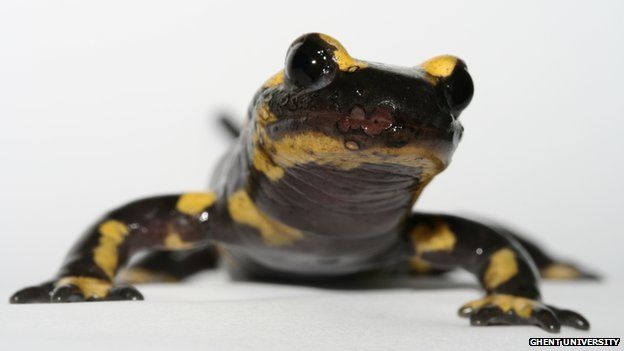Newt flesh fungus 'brought by pets'
- Published

Zoologists say a skin-eating fungus threatens salamanders and newts across Europe, and probably arrived on pet amphibians imported from Asia.
It was discovered in the Netherlands in 2013 after wiping out all but 10 of the country's fire salamanders.
Now tests show that the fungus causes deadly skin diseases in many related species, but not those from Asia.
The findings, published in Science, suggest that the fungus coexisted with Asian salamanders for 30 million years.
Researchers from Imperial College and the Zoological Society of London (ZSL) collaborated on the study with teams in the Netherlands and Belgium.
The parasitic fungus, called Batrachochytrium salamandrivorans, is related to another fungus (Batrachochytrium dendrobatidis) that causes a similar disease in frogs and other amphibians, mostly in the tropics.
According to the new study, the recently discovered "B. sal" does not affect frogs or toads but kills a wide variety of salamanders.
It rapidly invades and eats an animal's skin, which is crucial to its survival because it helps it to breathe.
"Most of the salamander species that come into contact with this fungus die within weeks," said lead author Prof An Martel from Ghent University, Belgium.
"There appear to be no real barriers that prevent the spread of the fungus throughout Europe."
Prof Martel and her team screened more than 5,000 amphibians from 35 different species, across four continents.
The results pointed the finger squarely at Asia as the most likely source.
"It's extremely lethal to most of the European salamanders that we tested, but it doesn't seem to cause serious disease in any of the Asian species," said Dr Trent Garner from ZSL's Institute of Zoology.
"The best explanation we have right now is this fungus originally arose in Asia."
Based on the evolutionary history of the group of Asian salamanders that can carry the fungus but survive, the team estimated that this branch of the family has lived with the fungus since the Palaeogene period, 30 million years ago.
They even detected the fungus in a museum specimen of an Asian newt dating from before 1870.
Since several species of Asian newts and salamanders are popular pets in Europe and the US, the animal trade seemed a likely explanation for the fungus turning up in Belgium.
To test this idea, the researchers also examined more than 2,000 skin samples from animals in museums and in pet shops around Europe, including Heathrow Airport, and at an export business in Hong Kong.
The pet shop samples were clean, but three specimens kept in European museums were infected - and had been imported from Asia in 2010.
This makes imported animals by far the most probable source. And although the pet shop samples in the study were fungus-free, this trade remains a likely explanation for the European outbreak because of the high numbers of amphibians that are imported to live in aquariums.
A particularly likely culprit is the Chinese fire-bellied newt, Cynops orientalis, which is such a common pet worldwide that 2.3 million arrived in the US between 2001 and 2009.
Dr Garner was keen to defend the newts themselves.
"Let's not call it a villain," he told the BBC. "They're not jumping onto aeroplanes of their own volition. Let's call it the poor, trafficked amphibian."
'In tears'
He emphasised that the invasion could be controlled by careful management.
"We've got to work towards controlling pathogens in the wildlife pet trade," Dr Garner said.
"Moving animals around moves their pathogens with them. Quite often in new situations, these pathogens have the weapons to overwhelm local hosts that haven't been exposed."
He also said efforts could be made to tackle the fungus in the wild.
"It's no longer a matter of populations just going down - we're actually seeing species being eliminated by new infectious diseases.
"I personally think that we can develop these mitigation techniques - we do it for livestock and we do it for humans."
Dr Garner has encountered widespread public interest in these issues in the UK.
"We've had ranavirus causing common frogs to die in the UK for 20 years. We're constantly hearing from people walking out and finding dead frogs in ponds in their own backyards. People are in tears!
"The British public really does care."
Although the "B. sal" fungus has not yet been found in the wild outside Belgium and the Netherlands, the researchers have said it is likely to spread further, because the animals pass it on when they touch each other.
The great crested newt, a protected species in the UK, is among the animals for whom the virus is fatal.
Follow Jonathan on Twitter
- Published3 September 2013
- Published17 October 2014
- Published15 October 2014